12 – 24 JUNE 2024
By Jacob Roalef
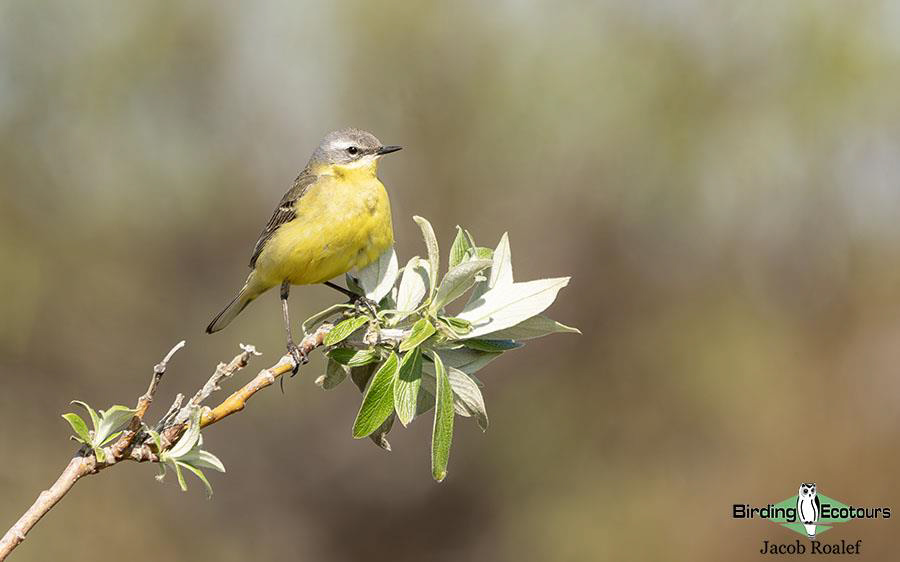
Our group enjoyed stellar views of this Eastern Yellow Wagtail in Nome.
Overview
This 13-day set departure tour of Alaska commenced in Anchorage, Alaska on the 12th of June 2024 and concluded back in Anchorage. The tour traveled throughout this massive state, including the Kenai Peninsula, the Denali region, and the old gold rush town of Nome. Numerous fantastic birding locations were visited, including Resurrection Bay, Kincaid Park, the Seward Mudflats, West Chester Lagoon, Potter Marsh, Hatcher’s Pass, Denali National Park, the Denali Highway, and many birding sites of Nome.
This tour connected with some fantastic species, including some true Alaskan specials, and many allowed us ample views to really study and appreciate each species. Visiting diverse habitats yielded a high-quality list over our 13 days in this arctic state. Avian highlights included Horned and Tufted Puffin, Red-faced Cormorant, Spruce Grouse, Bristle-thighed Curlew, Parakeet Auklet, Kittlitz’s Murrelet, Willow, Rock,and White-tailed Ptarmigan, Arctic and Aleutian Terns, Long-tailed Jaeger, Arctic Warbler, Eastern Yellow Wagtail, Bohemian Waxwing, Boreal Chickadee, Northern Hawk Owl, Gyrfalcon, Varied Thrush, and many more.
A total of 155 bird species were seen, with one additional heard only species, so the total recorded was 156. In addition to the birds, there were some amazing mammal highlights, including Black and Grizzly Bears, Moose, Humpback Whale, Sei Whale, Orca, Sea Otter, Steller Sea Lion, Muskox and Mountain Goat. Full bird and mammal checklists can be found at the end of the report.
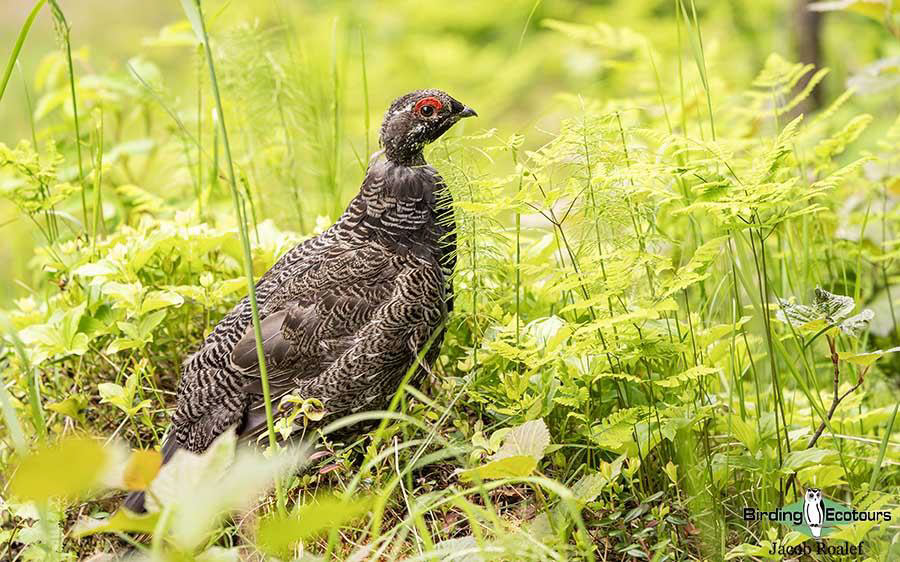
This spunky Spruce Grouse was certainly one of the more memorable birds of the trip.
Detailed Report
Day 1, 12th June 2024. Arrival and Anchorage birding
Today marked our first day of what was to be an amazing adventure in the wilderness of Alaska. Everyone on the tour had arrived early, so we met up in the afternoon to get some extra birding before dinner. We all said our hellos and introductions and were then off to Kincaid Park, a fantastic Anchorage park and birding location. We set off on our loop trail hike and quickly noted our first few species of the trip, Black-billed Magpie and Orange-crowned Warbler. As we got deeper into the coniferous forest, we were greeted by a very territorial Spruce Grouse, which trotted out onto the trail and began chasing us and pecked at our boots! It even followed us up the trail for a few hundred feet. As soon as the grouse had left us, we got onto an excellent flock of Two-barred (White-winged) Crossbills. However, the mosquitoes became thick and our pace through the park quickened. We did spot a few other great species though, like Boreal Chickadee, American Three-toed Woodpecker, and Swainson’s Thrush. We escaped the mosquitoes and still had some time before dinner, so we did a quick scan of the nearby Lake Hood and Lake Spenard. Here we picked up our first water birds of the trip, which included American Wigeon, Canvasback, Redhead, Red-necked Grebe, and Pacific Loon. With nearly 30 species in the bag already, we capped our successful first day with dinner and then went back to the hotel.
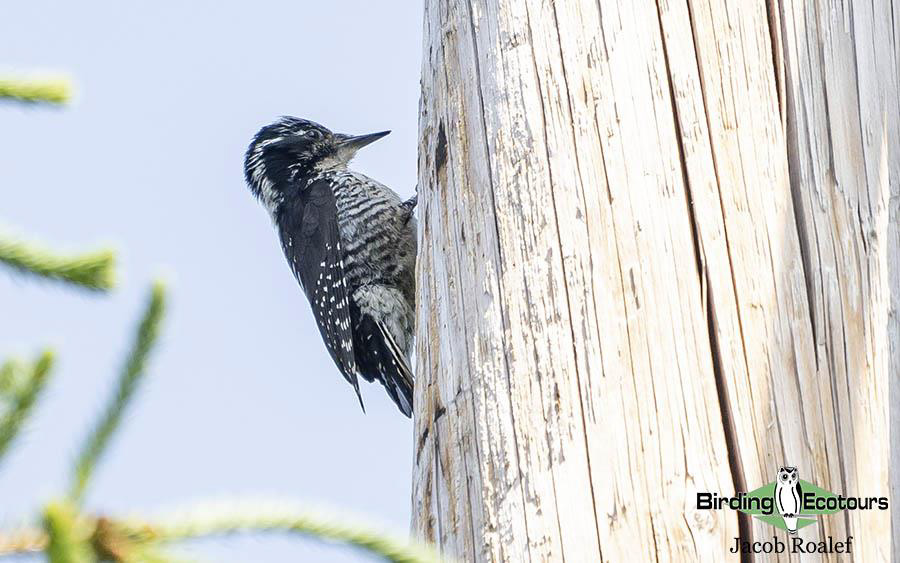
We scored some nice views of American Three-toed Woodpecker at Kincaid Park.
Day 2, 13th June 2024. South to Seward and the Kenai Peninsula
After breakfast, we headed out to do another quick scan of Lake Spenard to see if anything new had turned up. We managed to tick a few nice species like Greater Scaup, Spotted Sandpiper, and Bonaparte’s Gull before heading off to Potter Marsh, just outside of Anchorage. These gorgeous wetlands offer some incredible views from the boardwalk, with stunning mountains as the background. Here we picked up Alder Flycatcher, Bald Eagle, Lincoln’s Sparrow, Sandhill Crane, and a bull Moose working its way through the marsh with ease. From here we had some ground to cover to get to Seward with enough time to bird around town. A quick stop at Tern Lake yielded a distant Common Loon, but other than this, we simply enjoyed the views during the drive. Around mid-day we arrived in Seward, just in time for a tasty lunch next to the water. While waiting on the food, we noted Marbled Murrelet, Pigeon Guillemot, and Glaucous-winged Gull.
After lunch we headed off for the Seward mudflats and wetlands. The shorebirds today were sparse, but we picked up Greater Yellowlegs and Semipalmated Plover, as well as Savannah Sparrow, Ruby-crowned Kinglet, and Red-breasted Nuthatch. For the rest of the afternoon, we focused our efforts on the specialty species that nest in the temperate rainforest habitat of the Kenai Peninsula. We headed to Two Lakes Park, a hidden gem behind the neighborhoods of town. We set off on the loop trail through the huge coniferous forest full of ferns in the undergrowth. It wasn’t long before we heard the eerie call of a Varied Thrush echoing in the woods. We worked hard for visuals, but unfortunately never got great looks, so we pressed on. We came across a small mixed flock, including Townsend’s Warbler, Brown Creeper, Chestnut-backed Chickadee, and Golden-crowned Kinglet, all great species for this habitat. As we finished the loop, we scored nice views of Steller’s Jay and American Dipper, two more classic species. Just before dinner we cruised along the water’s edge and found a nice group of Harlequin Ducks. A nice species to cap off our first full day of birding in Alaska.
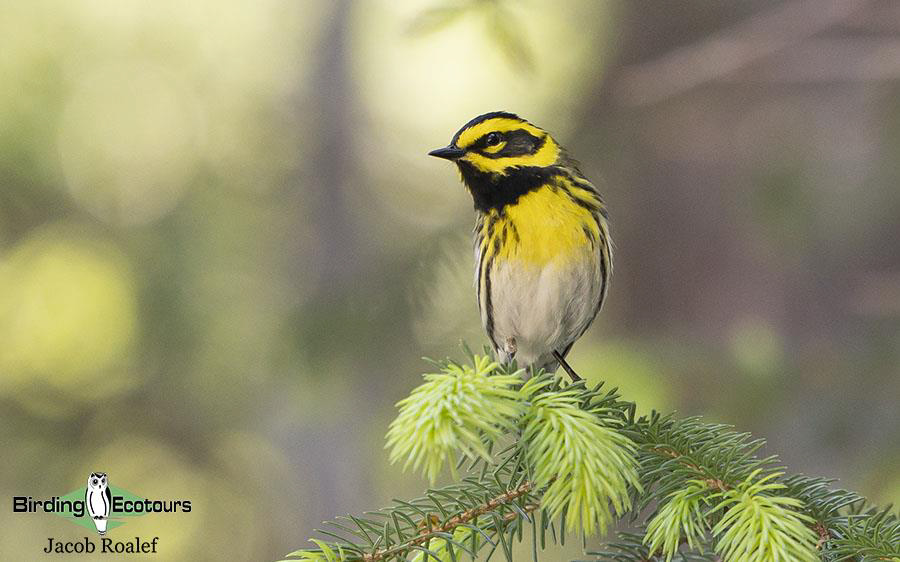
Townsend’s Warbler,with its striking colors, is always a favorite.
Day 3, 14th June 2024. Resurrection Bay pelagic to Northwestern Fjord
This morning was full of anticipation and excitement as we prepared for a full day on the water. We fueled up with some coffee and breakfast at a nearby Starbucks and then headed out for the docks to check in and board our boat. As we left the harbor, a Wandering Tattler jetted by, and we noted some of the more common species as well, like Black-legged Kittiwake and Double-crested Cormorant. The morning was dominated more by impressive mammals than birds as we watched a pod of Humpback Whales bubble net feeding, a very cool experience. After this we picked up on several other fantastic mammals, including Orca, Sei and Fin Whales, Sea Otter, Dall’s Porpoise, and Steller Sea Lion. While the mammals were incredible, our focus shifted back to birds as we approached Rugged Island. Here we picked up some excellent trip birds like Horned and Tufted Puffins, Surf Scoter, Common Murre, and a quick flyby Red-faced Cormorant. Just before lunch we approached the Chiswell Islands, another fantastic area for birding. Plenty of puffins were swimming in the water near the boat and then we picked up on a few Parakeet Auklets! As we patrolled the waters around the islands we picked up on several other key species like Thick-billed Murre, Rhinoceros Auklet, and Ancient Murrelet.
It was time for a picnic style lunch on board, and we took in the jaw-dropping scenery around us as we approached the Northwestern Fjord and glacier. As we got closer, large chunks of glacial ice floated by and some pieces were even large enough to support some Harbor Seals. We took in the stunning views of the glacier and then circled back out, with our focus now on a key species. Luckily, we managed to spot up to half a dozen Kittlitz’s Murrelets working the waters in this fjord. As we left the fjord, we spotted two Black Bears on the mainland, trotting along the bushes. Always a funny mammal to spot from a boat. On the way back to Seward, we made a few more stops at various islands, where we picked up on another Red-faced Cormorant. By the time we deboarded, it was already early evening, so we headed off for dinner and then off to bed.
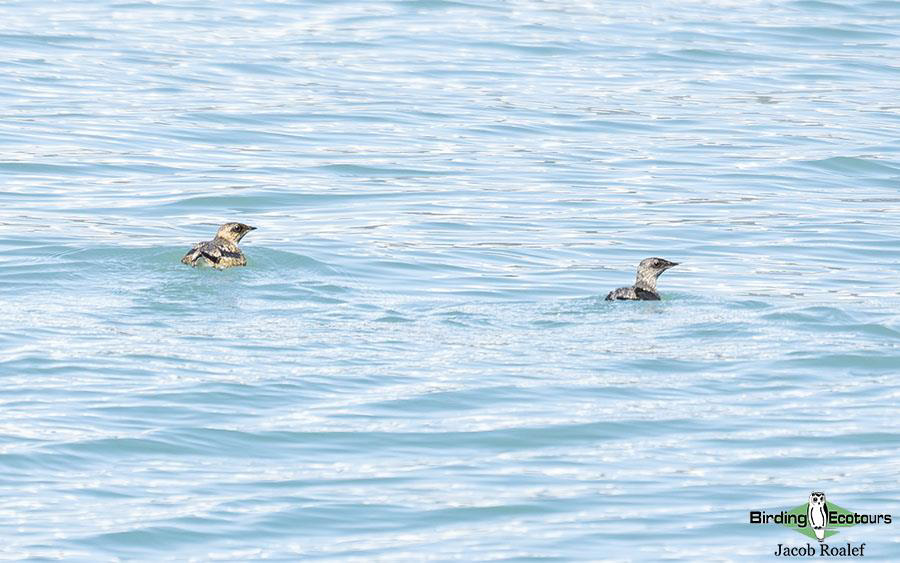
These Kittlitz’s Murrelets were one of the many highlights on our pelagic trip.
Day 4, 15th June 2024. Seward and flight to Nome
Today we were up and out early to get some pre-breakfast birding in. We headed off to the southern end of Seward at Lowell Point, more old growth temperate rainforest habitat. As soon as we opened the doors, we heard the echoing Varied Thrush, happily, this morning provided much better views of one as well. We hiked a short way up the hill and picked up Brown Creeper and some close views of a Sooty Fox Sparrow. Back in the parking lot, we played hide-and-seek with a pesky Pacific Wren before loading back up and heading for breakfast. While we waited in line to order, we spotted a Grizzly Bear family up on a nearby mountain and managed to scope them from down below. This made waiting for food a little more exciting! After breakfast we loaded up the van and headed to one final stop just outside of Seward, called Ava’s place, a lovely feeding station area. Sadly, we learned that Ava had recently passed, but her niece was keeping the place up and welcoming birders. It was so good of her to do this, and we enjoyed loads of nice species in her yard, like Red Crossbill, Downy and Hairy Woodpeckers, Pine Grosbeak, Rufous Hummingbird, and Pine Siskin. This was all an ode and testament to Ava’s hard work and dedication to these birds, for which we are certainly forever grateful.
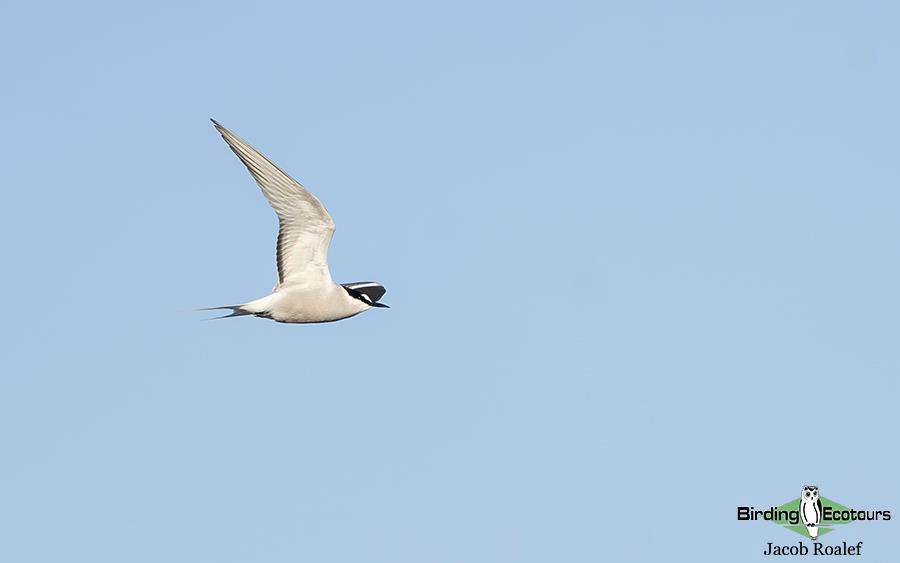
This Aleutian Tern made a close fly-by one evening in Nome.
The rest of the morning and into the afternoon was spent driving back to Anchorage, dropping off the van, having lunch, and all getting checked in at the airport for our mid-afternoon flight to Nome. While in the air, it was possible to see Mount Denali in all its glory out in the distance. As always, it was stunning to fly over Alaska’s incredible landscape. When we arrived in Nome it was already evening, so we got our things, sorted out the vehicle and hotel, then went for dinner. Since the sun never really sets this time of year, there was plenty of light for some optional post-dinner birding. We loaded up and headed to the Nome River mouth for about an hour or so of bonus birding. As we approached, we came across a birding friend who informed us of a rarity right where we were headed! We walked the beach and ticked some of our first Nome species, like Glaucous Gull, Red-throated Loon, and Common Redpoll. The mudflats here were loaded with birds to pick through and it wasn’t long before we spotted the rarity, Siberian Sand Plover! A fantastic species to kick off our Nome birding. Of course, there were many other fantastic species here as well, like Bar-tailed Godwit, Western Sandpiper, Hudsonian Whimbrel, Long-tailed Duck, Sabine’s Gull, and a pair of mating Aleutian Terns. We were even lucky enough to have an Aleutian Tern flyby right overhead. Our time in Nome was off to a fantastic start, but we needed to rest before tomorrow’s adventures.
Day 5, 16th June 2024. Nome – Teller Road
Today our goal was to go as far down Teller Road as time would allow. We filled up on some tasty breakfast, packed our gear and hit the road. Just outside of town we made our first stop when we spotted a herd of Muskoxen, our first of the tour. While we were out of the van, we noticed quite a bit of bird activity, so we spent some time here to nail down the more common species now and then focus on the more difficult and specialty species later. These common birds included American Yellow, Blackpoll, and Wilson’s Warblers, Northern Waterthrush, Common Redpoll, and Grey-cheeked Thrush. We also picked up a few less common species like Great Grey (Northern) Shrike and Rusty Blackbird. A solid first stop of the day. As we continued along, we noted plenty of Wilson’s Snipes on top of poles and roofs, and one was even perched on a wire! We also picked up Northern Harrier, Long-tailed Jaeger, and Cliff Swallow from the van. As we drove, we heard the song of an Arctic Warbler singing from the window, so we all filed out to search for it. Thankfully, it gave multiple views, for everyone to see it well. While we were stopped, we spotted a Red Fox Sparrow as well.
Eventually we made it to a rocky outcrop which proved to be a good spot to stop and have our picnic lunch. While we ate, we were serenaded by a stunning Bluethroat as it put on quite the show, a true specialty of Nome. We also enjoyed Lapland Longspur and Golden-crowned Sparrow during lunch. Back on the main road we stumbled across a large covey of Willow Ptarmigans, a species we regularly saw along the roads in Nome. While the willow was common, its cousin the Rock Ptarmigan proved to be very elusive. We spent several hours searching diligently for one, in fantastic habitat, but all we came away with were several American Golden Plovers. We continued a bit further up the main road, always with eyes peeled for ptarmigans, until we made it to the Crete Creek and Wooley Lagoon area. Here we got out, enjoyed some cookies, and resumed our search. In no time at all, Rita was on an interesting bird, perched way out on a rock, so we all rushed to investigate. A female Northern Wheatear sat there quite nicely for all of us to enjoy, and then we discovered the male, another fantastic Nome specialty, nearby as well. Our time was running low, so we loaded up and began the journey back to town, albeit slowly because of the good habitat. Finally, a white rock shape began to move. Rock Ptarmigan! After so much painstaking searching, our persistence paid off and we finally had our silly chicken-like bird in the bag. This made the long drive back to town much easier. When we arrived, it was time for dinner, so we shared some tasty pizza and went through our checklists. We called it a night, as we were all feeling tired after a long day on Teller Road.
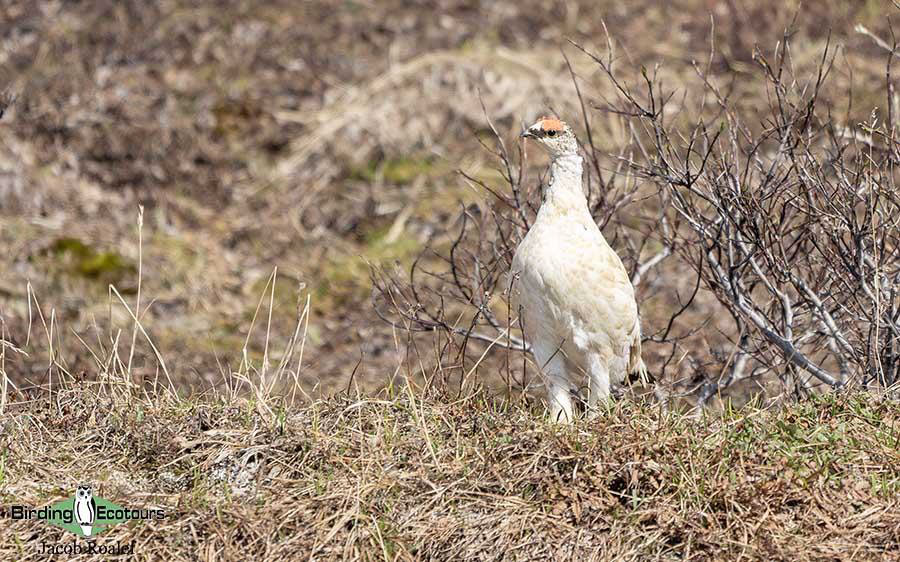
Rock Ptarmigan eluded us for a long time, but we were successful in the end.
Day 6, 17th June 2024. Nome – Kougarok Road
This morning, we hit the road early because we had a lot of ground to cover on the Kougarok Road to get to Coffee Dome during morning hours. After about 40 minutes, we made a stop for a little birding while we ate breakfast. This was a known spot with an active Gyrfalcon nest on the cliffside. After some quick scanning we spotted one adult way up on the ridge. An excellent start to the morning. As we drove, we noted some waterfowl species that were new for the trip, like Tundra Swan, Greater White-fronted Goose, and Cackling Goose. We arrived at Coffee Dome, a local name for a nearby mountain in the tundra, just before 10am. As we exited the van, we spotted a Northern Harrier being harassed by a Short-eared Owl out in the distance. It was time to begin our hike up the mountain, through the tricky tundra terrain. Slow and steady was the name of the game when it came to this hike. As we ascended, we picked up a few American Tree Sparrows, a new species for the trip. Eventually, we made it to the flat top, where we began our more in-depth search for our top target. We carefully navigated the terrain and had a few false alarms with Hudsonian Whimbrel and American Golden Plover on the tundra. Out in the distance, a Long-tailed Jaeger flushed up several large waders and gave us lead onto which direction to walk. Shortly after, we heard the whistle call of our target, a Bristle-thighed Curlew, as it passed by overhead! With some effort we managed to spot another one, this time on the tundra ground, where we could see its bristle-thighs in the scope. A great reward for our efforts.
After we climbed back down, we began the long journey back towards Nome. We made a stop along the Kuzitrin River to have our picnic lunches and stretch our legs. There were some nice birds to enjoy, like American Yellow and Orange-crowned Warblers, Sand Martin, Cliff Swallow, and a Say’s Phoebe, new for the trip. We loaded up and continued along the Kougarok Road until we made it back to the falcon nesting area. Another stop, this time with better light, yielded views of the nest with three young, plus a view of the other parent, a nice white Gyrfalcon. By late afternoon, we made it back to Nome and made a quick stop at the dump to search for gulls. There were plenty of Common Ravens, Short-billed and Glaucous Gulls and, after some careful scanning, we turned up a Glaucous-winged Gull, a nice Vega Gull, and a Sandhill Crane picking through the garbage. We still had some time before dinner, so we made a quick stop for a scan of the Nome River mouth. We spotted loads of nice species like Pacific Golden Plover, Bar-tailed Godwit, Western Sandpiper, Red-breasted Merganser, and more. With our last few minutes before dinner, we decided to do a little driving through town to check on some wetland areas and around the harbor. As we pulled up, a White Wagtail flew over the wetland, and we watched as it headed for town. Unfortunately, we were unable to relocate it and gave up for the day, to have dinner.
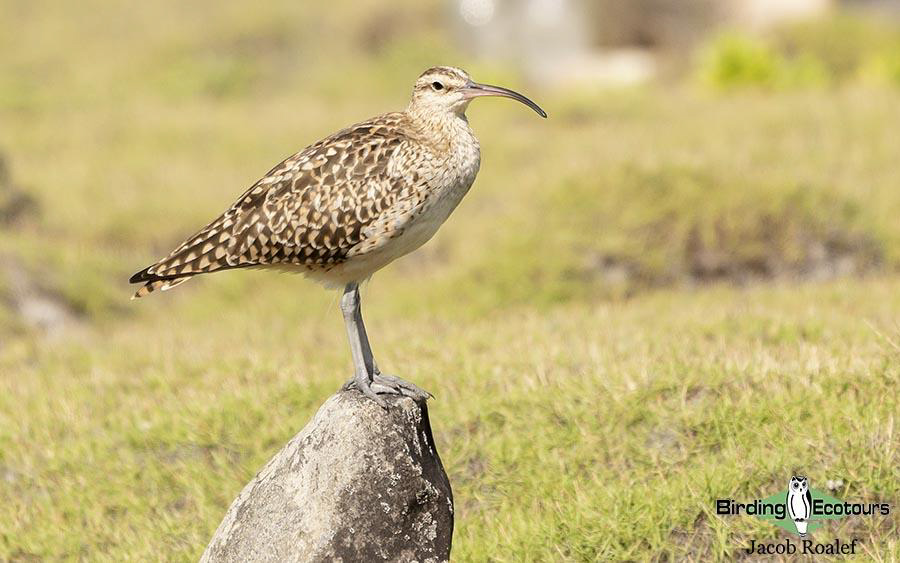
After a tough tundra hike, we were rewarded with a Bristle-thighed Curlew.
Day 7, 18th June 2024. Nome – Council Road and back to Anchorage
On our final day in Nome, it was time to explore the final road, Nome-Council Road. After some tasty breakfast and coffee in town we set off, our first stop being the Nome River bridge. We spotted an Aleutian Tern out on the sand bank, a nice bird for those who missed it on the first night here. We continued until we reached Cape Nome, a small jetty out into the Bearing Sea, to do some sea watching. Right away we noticed a raft of Harlequin Ducks floating along the rocky shore. Our seawatch produced some nice species like Thick-billed and Common Murres, Surf Scoter, Long-tailed Duck, Horned Puffin, Black-legged Kittiwake, and Brant. After about an hour, freezing from the cold wind, we filed back into the van to warm up. As we drove along Safety Sound, we stopped anytime we saw something interesting. These stop and scans produced some excellent birds like Canvasback, Common Goldeneye, Common Eider, Semipalmated Plover, Pacific and Red-throated Loons, Dunlin, and over 100 Tundra Swans! Eventually, we reached our terminus for the day, a collection of houses known as Solomon. Before we even got out, we had eyes on an Eastern Yellow Wagtail, another fantastic Nome specialty. We decided to eat our lunch here and enjoy three of these Eastern Yellow Wagtails singing and flying about. We also noted Lapland Longspur, Common Redpoll, and Savannah Sparrow while we ate.
After lunch, it was time to begin our journey back to town since we had a late afternoon flight to catch back to Anchorage. We did have time for some birding and stops on the way back. First, we checked out the Last Train to Nowhere, a popular tourist stop. We made another quick scan from Cape Nome, but unfortunately, nothing new was seen. As we approached town, we noticed a larger, heavier looking jaeger species flying low. When it appeared over the horizon again, it was clear that we had a Parasitic Jaeger, a first for the trip. We spent the remainder of our time here preparing for the flight, sorting out our luggage, and getting to the airport. We boarded our flight, landed in Anchorage, caught the ferry shuttle, and had a late dinner after a long day of birding and traveling.
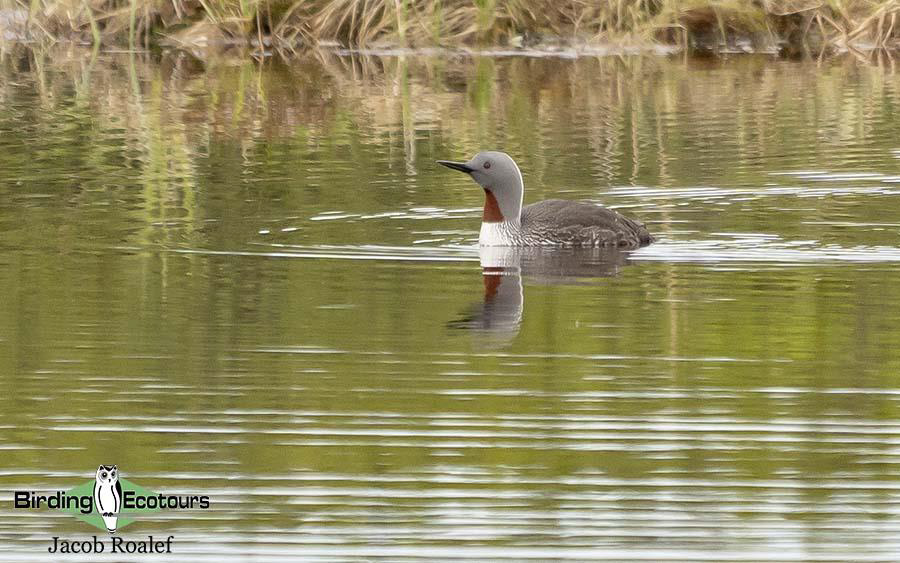
Seemingly every other pond had a Red-throated Loon on it this year.
Day 8, 19th June 2024. Anchorage to Palmer
Everyone enjoyed a more leisurely start to the day, after the fast-paced start to the trip and the long night getting back to Anchorage. We all slept in some and enjoyed breakfast at the hotel before loading up. The plan for today was a bit more relaxed with our final destination of Palmer. First up was some birding at local Anchorage parks. We made our usual check of Spenard Lake, hoping for something new. We turned up a few Horned Grebes along with the usual suspects, like Lesser Scaup, Red-necked Grebe, and Black-billed Magpie. Next, we made our way over to the lovely Westchester Lagoons. It was a gorgeous day, the park was full of happy local folks riding bikes or walking, so we followed suit and enjoyed a pleasant walk around. There were plenty of birds to look at, like American Wigeon, White-crowned Sparrow, and Sandhill Crane. The favorite though might have been the baby Short-billed Gulls still fluffy with down feathers. From here we headed for lunch and stopped at a local store to replace some boots that had bitten the dust back in Nome. After we ate and shopped, we did some afternoon birding at the Palmer Hay Flats boardwalk trail. There were plenty of nice birds on the trail, including a new one for the trip, Western Wood-Pewee. Other species included Alder Flycatcher, Northern Waterthrush, Blackpoll Warbler, Rusty Blackbird, Lincoln’s Sparrow, and Bald Eagle. After a little over an hour, we packed back into the van and headed over to our hotel in Palmer. We all enjoyed a short break before dinner. Overall, we had a relaxing day of birds and perfect weather, just what we needed to recharge after an eventful first seven days.
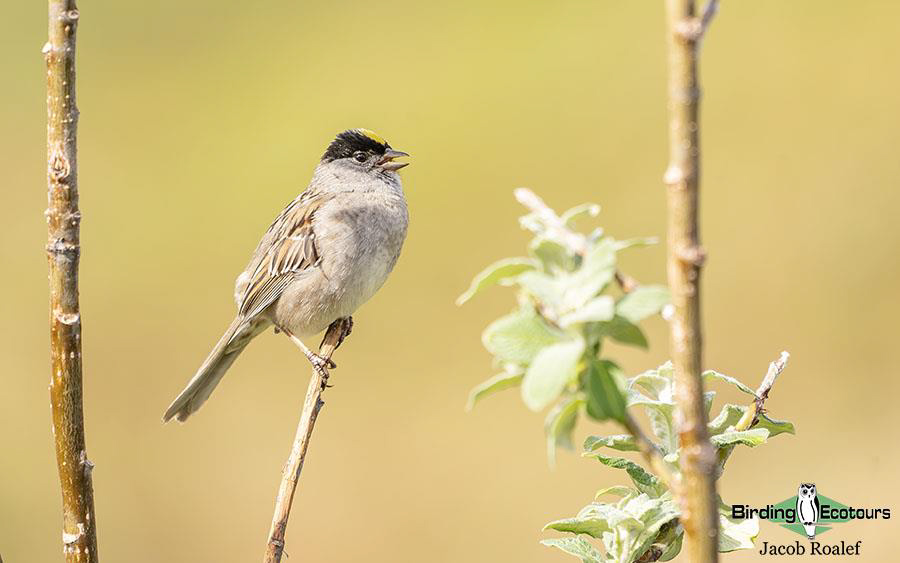
This dapper Golden-crowned Sparrow gave some nice views as it sang.
Day 9, 20th June 2024. Hatcher Pass to Healy
We started the morning with a hearty breakfast and coffee at the Noisy Goose café, and then hit the road to Hatcher Pass. Our first birding stop was at a nearby bridge overlooking some fast rapids. After a brief wait, we spotted an American Dipper working the rocks of the river. It is always incredible to watch this bird navigate the fast-flowing waters. We continued to the Gold Mint Trailhead to stretch our legs and use the restroom as needed. Here we spotted a few nice birds, like White-crowned Sparrow and Wilson’s Warbler. Next up was the Independence Mine, a former gold mining operation. Here we scoured the tundra habitat and cliffs and spotted Golden-crowned and Savannah Sparrows. Back by the van, a couple of Hoary Marmots were seen going in and out of burrows. While we watched these interesting mammals, we spotted a Golden Eagle soar up and over the cliffs. As we continued along Hatcher Pass, enjoying the amazing scenery and views, we spotted another friendly group of birders. All their scopes were pointed in the same direction, always a good sign for a good bird. We quickly hopped out and were on an incredibly camouflaged White-tailed Ptarmigan! A very difficult species for Alaska, and a great one for us since it gave us the ptarmigan sweep for our trip. We spent some time here to enjoy this great species, and some of us even clambered up the rocky slope to get a better view of the accommodating White-tailed Ptarmigan. The remaining sections of the pass served mostly as breathtaking views up in the tundra-mountains. As we climbed down, we spotted a pair of Common Mergansers along a small stream, a nice new species for the trip. Eventually, we joined back to the main road, highway three, and headed towards Willow for lunch.
There was still a lot of ground to cover after lunch, so we hit the road and made it to our next birding stop, known as the sockeye burn area. This recently burned section of conifers looked like great habitat for woodpeckers and other forest species. We birded all along the roadsides here and picked up Hairy and American Three-toed Woodpeckers, Dark-eyed Junco, Swainson’s Thrush, and Alder Flycatcher. Sadly, no new species for our trip list, so we continued along until we reached Denali viewpoint south. This was an excellent stop to stretch our legs and, since it was a clear day, we could see Mount Denali out in the distance. About 100 miles (161km) further, we reached the entrance to Denali National Park, where the customary Moose was waiting to welcome us. We handled the check-in information for our trip into the park the next day. It was already evening, and some rain started falling, so we called it a day and headed for dinner.
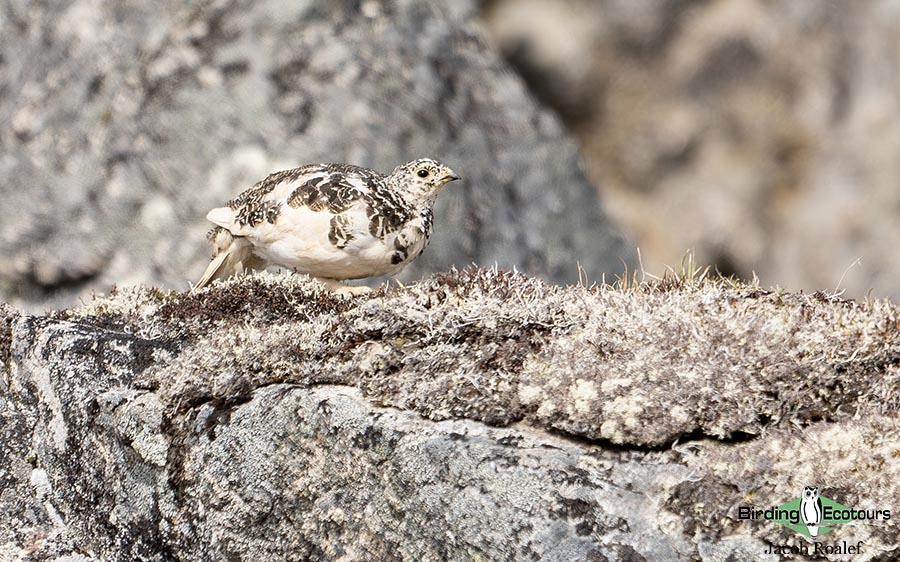
This White-tailed Ptarmigan gave us the ptarmigan sweep for the trip!
Day 10, 21st June 2024. Denali National Park
Our scheduled trip into Denali National Park was on an afternoon bus, so we had some time this morning for other birding and activities around the park. We started off before breakfast at the nearby Otto Lake and picked Bufflehead, new for the trip, as well as Lesser Scaup, Spotted Sandpiper, and Semipalmated Plover. After our quick scan, we headed for Rose’s Café for a tasty breakfast. In the parking lot, we spotted a Canada Jay, another new trip species. The day was already off to a great start. We decided to head into the park and check out the Denali sled dog rescue team. On the way in, we spotted a Great Horned Owl perched nicely on a conifer. With some quick investigation, it turned into a family affair, with a few recent fledglings nearby as well. After watching the interesting dog demonstration, we had some time to check out the main visitor center of this impressive national park. We then headed off to the bus depot to line up and wait for our tour into Denali National Park.
Our Tundra Wilderness Tour took us through the beauty of this pristine and wild park, all the way to mile-marker 43 (km-63) on the road where an extreme washout happened and is currently under repair. Regular vehicles are not permitted past the Savage River checkpoint. On our trip, we saw and experienced all the amazing habitats firsthand, and learnt about the history of the park, which was really what this day was all about. We spotted Dall’s Sheep several times throughout the day, as well as Moose, Arctic Ground Squirrel, and Northern Harrier. Towards the end of the road, we managed to get onto a family unit of Brown (Grizzly) Bears, a mom and two cubs. This is always a special sighting inside Denali. On our way back to the depot, we spotted a nice Willow Ptarmigan, as well as an adorable North American Porcupine trotting along the side of the road. A couple of nice sightings to cap off an excellent day inside Denali National Park.
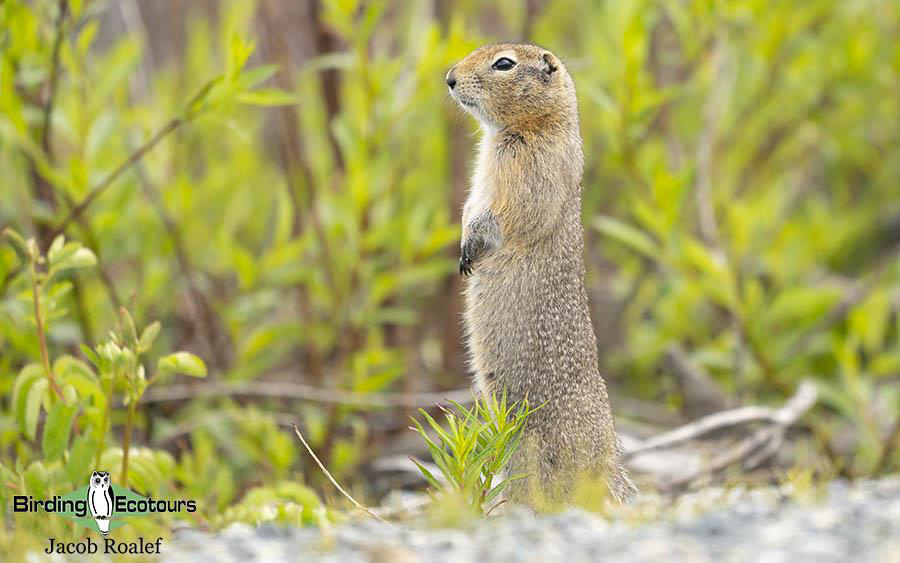
The Arctic Ground Squirrel was common throughout the Denali region.
Day 11 22nd June 2024. Birding the Denali Highway
This morning, we loaded up the van and hit the road for a 30-minute drive before our first stop at a lovely local café for breakfast. After filling up on tasty food, we spotted our first Northern Flicker of the trip, in the parking lot. We hit the road and began our long journey down the scenic 135-mile (217 km) Denali Highway. Our stop was at a lovely lake about 10 miles (16 km) down the road. Here we noted Trumpeter Swan, Green-winged Teal, Red-necked Phalarope, and White-winged Scoter, a new species for the trip. We continued and made stops and scans anytime we saw water, or anything promising. This yielded species like Canada Jay, Northern Pintail, Common Redpoll, White-crowned Sparrow, and more. One of our stops was at a higher point in the road, where we looked down over the incredible landscape, with stunning mountains in the distance. We picked up a small flock of Bohemian Waxwings, always an impressive species.
The journey continued with much of the same, picking up more species as we went, like Lesser Yellowlegs, Least Sandpiper, Short-billed Gull, Red-throated Loon, and Arctic Tern. At a pleasant river crossing along the road, we stopped for a break from driving and to enjoy our picnic style lunch. A few songbirds, like Wilson’s and Myrtle Warblers, were active in the nearby bushes. Some of us went for a short hike through the tundra habitat, but the birding was slow, so we headed back and finished our route along the Denali Highway. It was already late afternoon when we arrived at the other side, and we still had a long journey to reach our hotel in Glennallen. We buckled down and hit the road, with few stops along the way. When we reached the hotel, we relaxed, enjoyed a tasty dinner, and hit the hay.
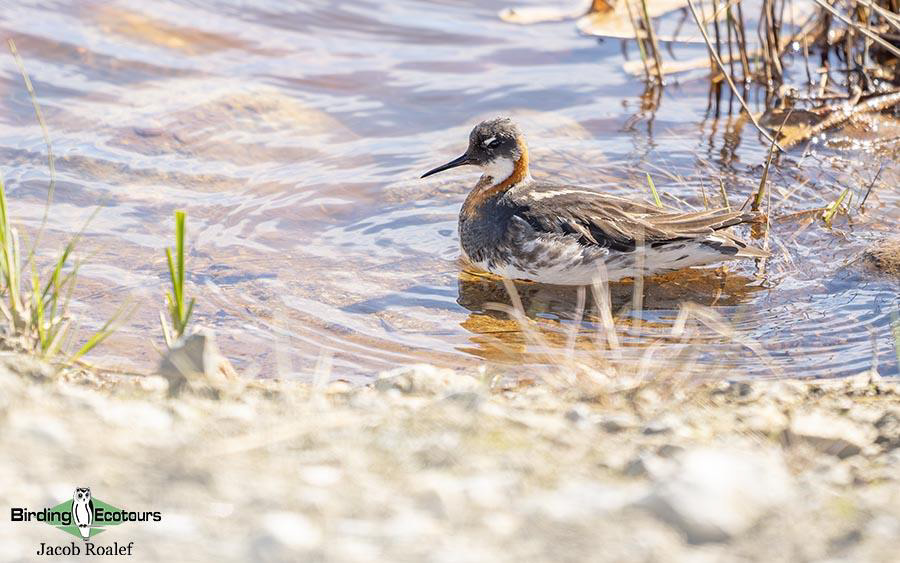
It was great to see a Red-necked Phalarope spinning in the water.
Day 12, 23rd June 2024. Back to Anchorage
After our long day in the van yesterday, we enjoyed a more leisurely morning, with breakfast at our hotel and time to do any extra packing. Around mid-morning we set off on our journey back to Anchorage, along the Glenn Highway. Again, we had a lot of ground to cover due to Alaska’s huge size. As we drove, we constantly scanned the coniferous forests in hopes of finding our final target species. A very rounded Canada Jay provided an exciting false alarm. Fortunately, our efforts eventually paid off, when we spotted a distant Northern Hawk Owl teed up on top of a pine. It stayed just long enough for everyone to see in the scope, before disappearing. A stunning Bald Eagle flew by and perched, to keep us entertained. We pressed on and spotted another new species, American Kestrel, which was unexpected here. Around mid-day we made it to a nice pull-off area with restrooms and a scenic view of the Matanuska Glacier, a great spot to enjoy a picnic lunch. The remainder of the day consisted mostly of driving and getting to our hotel. Some of us enjoyed a little birding around Spenard Lake, where we noted the usual suspects, like Lesser Scaup, Pacific Loon, and Red-necked Grebe. At our final dinner together, we shared some of our favorite species and moments of the trip, then called it a day and headed back to the hotel.
Day 13, 24th June 2024. Tour conclusion and start of extension
Our final morning saw the end to our main Alaska tour adventure and the beginning of our Alaska Extension to Utqiagvik. For some, this was the final morning, with breakfast at the hotel and the shuttle service taking them to the Anchorage airport for departure towards home. For the rest of us, we relaxed and then headed to the airport, to meet up with several new group members who were joining us, and to catch our flight north for our next adventure. Of course, this main tour was quite an adventure in itself, full of fantastic birds, mammals, and scenery.
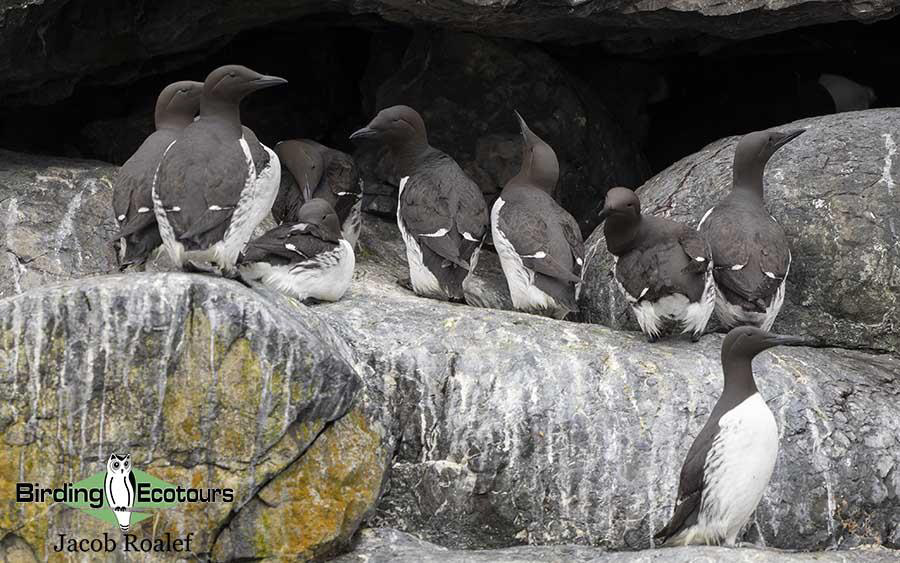
The pelagic full of wildlife, like these Common Murres, was a top highlight for everyone.
Bird List – Following IOC (14.1 – December 2023 version)
Birds ‘heard only’ are marked with (H) after the common name, all other species were seen.
The following notation after species names is used to show conservation status following BirdLife International: EN = Endangered, VU = Vulnerable.
| Common Name | Scientific Name |
| Ducks, Geese, Swans (Anatidae) | |
| Brant Goose | Branta bernicla |
| Canada Goose | Branta canadensis |
| Cackling Goose | Branta hutchinsii |
| Greater White-fronted Goose | Anser albifrons |
| Trumpeter Swan | Cygnus buccinator |
| Tundra Swan | Cygnus columbianus |
| Northern Shoveler | Spatula clypeata |
| Gadwall | Mareca strepera |
| Eurasian Wigeon | Mareca penelope |
| American Wigeon | Mareca americana |
| Mallard | Anas platyrhynchos |
| Northern Pintail | Anas acuta |
| Green-winged Teal | Anas carolinensis |
| Canvasback | Aythya valisineria |
| Redhead | Aythya americana |
| Ring-necked Duck | Aythya collaris |
| Greater Scaup | Aythya marila |
| Lesser Scaup | Aythya affinis |
| Common Eider | Somateria mollissima |
| Harlequin Duck | Histrionicus histrionicus |
| Surf Scoter | Melanitta perspicillata |
| White-winged Scoter | Melanitta deglandi |
| Black Scoter | Melanitta americana |
| Long-tailed Duck – VU | Clangula hyemalis |
| Bufflehead | Bucephala albeola |
| Common Goldeneye | Bucephala clangula |
| Common Merganser | Mergus merganser |
| Red-breasted Merganser | Mergus serrator |
| Pheasants & Allies (Phasianidae) | |
| Willow Ptarmigan | Lagopus lagopus |
| Rock Ptarmigan | Lagopus muta |
| White-tailed Ptarmigan | Lagopus leucura |
| Spruce Grouse | Canachites canadensis |
| Grebes (Podicipedidae) | |
| Red-necked Grebe | Podiceps grisegena |
| Horned Grebe – VU | Podiceps auritus |
| Pigeons, Doves (Columbidae) | |
| Rock Pigeon (Introduced) | Columba livia |
| Cranes (Gruidae) | |
| Sandhill Crane | Antigone canadensis |
| Hummingbirds (Trochilidae) | |
| Rufous Hummingbird | Selasphorus rufus |
| Oystercatchers (Haematopodidae) | |
| Black Oystercatcher | Haematopus bachmani |
| Plovers (Charadriidae) | |
| Pacific Golden Plover | Pluvialis fulva |
| American Golden Plover | Pluvialis dominica |
| Semipalmated Plover | Charadrius semipalmatus |
| Siberian Sand Plover (Rarity) | Charadrius mongolus |
| Sandpipers, Snipes (Scolopacidae) | |
| Bristle-thighed Curlew | Numenius tahitiensis |
| Hudsonian Whimbrel | Numenius hudsonicus |
| Bar-tailed Godwit | Limosa lapponica |
| Black Turnstone | Arenaria melanocephala |
| Dunlin | Calidris alpina |
| Least Sandpiper | Calidris minutilla |
| Semipalmated Sandpiper | Calidris pusilla |
| Western Sandpiper | Calidris mauri |
| Wilson’s Snipe | Gallinago delicata |
| Red-necked Phalarope | Phalaropus lobatus |
| Spotted Sandpiper | Actitis macularius |
| Wandering Tattler | Tringa incana |
| Lesser Yellowlegs | Tringa flavipes |
| Greater Yellowlegs | Tringa melanoleuca |
| Gulls, Terns, Skimmers (Laridae) | |
| Black-legged Kittiwake – VU | Rissa tridactyla |
| Sabine’s Gull | Xema sabini |
| Bonaparte’s Gull | Chroicocephalus philadelphia |
| Short-billed Gull | Larus brachyrhynchus |
| Glaucous-winged Gull | Larus glaucescens |
| Glaucous Gull | Larus hyperboreus |
| American Herring Gull | Larus smithsonianus |
| Vega Gull | Larus vegae |
| Aleutian Tern – VU | Onychoprion aleuticus |
| Arctic Tern | Sterna paradisaea |
| Skuas (Stercorariidae) | |
| Parasitic Jaeger | Stercorarius parasiticus |
| Long-tailed Jaeger | Stercorarius longicaudus |
| Auks (Alcidae) | |
| Parakeet Auklet | Aethia psittacula |
| Thick-billed Murre | Uria lomvia |
| Common Murre | Uria aalge |
| Pigeon Guillemot | Cepphus columba |
| Marbled Murrelet – EN | Brachyramphus marmoratus |
| Kittlitz’s Murrelet | Brachyramphus brevirostris |
| Ancient Murrelet | Synthliboramphus antiquus |
| Rhinoceros Auklet | Cerorhinca monocerata |
| Horned Puffin | Fratercula corniculata |
| Tufted Puffin | Fratercula cirrhata |
| Loons (Gaviidae) | |
| Red-throated Loon | Gavia stellata |
| Pacific Loon | Gavia pacifica |
| Common Loon | Gavia immer |
| Cormorants and Shags (Phalacrocoracidae) | |
| Red-faced Cormorant | Urile urile |
| Pelagic Cormorant | Urile pelagicus |
| Double-crested Cormorant | Nannopterum auritum |
| Kites, Hawks, Eagles (Accipitridae) | |
| Golden Eagle | Aquila chrysaetos |
| Northern Harrier | Circus hudsonius |
| Bald Eagle | Haliaeetus leucocephalus |
| Owls (Strigidae) | |
| Northern Hawk-Owl | Surnia ulula |
| Short-eared Owl | Asio flammeus |
| Great Horned Owl | Bubo virginianus |
| Woodpeckers (Picidae) | |
| American Three-toed Woodpecker | Picoides dorsalis |
| Downy Woodpecker | Dryobates pubescens |
| Hairy Woodpecker | Leuconotopicus villosus |
| Northern Flicker | Colaptes auratus |
| Caracaras, Falcons (Falconidae) | |
| American Kestrel | Falco sparverius |
| Gyrfalcon | Falco rusticolus |
| Tyrant Flycatchers (Tyrannidae) | |
| Say’s Phoebe | Sayornis saya |
| Western Wood Pewee | Contopus sordidulus |
| Alder Flycatcher | Empidonax alnorum |
| Shrikes (Laniidae) | |
| Northern Shrike | Lanius borealis |
| Crows, Jays, and Magpies (Corvidae) | |
| Canada Jay | Perisoreus canadensis |
| Steller’s Jay | Cyanocitta stelleri |
| Black-billed Magpie | Pica hudsonia |
| American Crow | Corvus brachyrhynchos |
| Northern Raven | Corvus corax |
| Waxwings (Bombycillidae) | |
| Bohemian Waxwing | Bombycilla garrulus |
| Tits, Chickadees, and Titmice (Paridae) | |
| Chestnut-backed Chickadee | Poecile rufescens |
| Boreal Chickadee | Poecile hudsonicus |
| Black-capped Chickadee | Poecile atricapillus |
| Larks (Alaudidae) | |
| Horned Lark (H) | Eremophila alpestris |
| Swallows (Hirundinidae) | |
| Sand Martin (Bank Swallow) | Riparia riparia |
| Tree Swallow | Tachycineta bicolor |
| Violet-green Swallow | Tachycineta thalassina |
| American Cliff Swallow | Petrochelidon pyrrhonota |
| Leaf Warblers & Allies (Phylloscopidae) | |
| Arctic Warbler | Phylloscopus borealis |
| Kinglets (Regulidae) | |
| Ruby-crowned Kinglet | Corthylio calendula |
| Golden-crowned Kinglet | Regulus satrapa |
| Nuthatches (Sittidae) | |
| Red-breasted Nuthatch | Sitta canadensis |
| Treecreepers (Certhiidae) | |
| Brown Creeper | Certhia americana |
| Wrens (Troglodytidae) | |
| Pacific Wren | Troglodytes pacificus |
| Dippers (Cinclidae) | |
| American Dipper | Cinclus mexicanus |
| Starlings (Sturnidae) | |
| European Starling (Introduced) | Sturnus vulgaris |
| Thrushes and Allies (Turdidae) | |
| Varied Thrush | Ixoreus naevius |
| Swainson’s Thrush | Catharus ustulatus |
| Hermit Thrush | Catharus guttatus |
| Grey-cheeked Thrush | Catharus minimus |
| American Robin | Turdus migratorius |
| Chats, Old World Flycatchers (Muscicapidae) | |
| Bluethroat | Luscinia svecica |
| Northern Wheatear | Oenanthe oenanthe |
| Wagtails and Pipits (Motacillidae) | |
| Eastern Yellow Wagtail | Motacilla tschutschensis |
| White Wagtail | Motacilla alba |
| Finches, Euphonias, and Allies (Fringillidae) | |
| Pine Grosbeak | Pinicola enucleator |
| Common Redpoll | Acanthis flammea |
| Arctic Redpoll | Acanthis hornemanni |
| Red Crossbill | Loxia curvirostra |
| Two-barred Crossbill | Loxia leucoptera |
| Pine Siskin | Spinus pinus |
| Longspurs and Snow Buntings (Calcariidae) | |
| Lapland Longspur | Calcarius lapponicus |
| Snow Bunting | Plectrophenax nivalis |
| New World Sparrows (Passerellidae) | |
| Sooty Fox Sparrow | Passerella unalaschcensis |
| Red Fox Sparrow | Passerella iliaca |
| American Tree Sparrow | Spizelloides arborea |
| Dark-eyed Junco | Junco hyemalis |
| White-crowned Sparrow | Zonotrichia leucophrys |
| Golden-crowned Sparrow | Zonotrichia atricapilla |
| Savannah Sparrow | Passerculus sandwichensis |
| Song Sparrow | Melospiza melodia |
| Lincoln’s Sparrow | Melospiza lincolnii |
| Oropendolas, Orioles, Blackbirds (Icteridae) | |
| Rusty Blackbird – VU | Euphagus carolinus |
| New World Warblers (Parulidae) | |
| Northern Waterthrush | Parkesia noveboracensis |
| Orange-crowned Warbler | Leiothlypis celata |
| American Yellow Warbler | Setophaga aestiva |
| Blackpoll Warbler | Setophaga striata |
| Myrtle Warbler | Setophaga coronata |
| Townsend’s Warbler | Setophaga townsendi |
| Wilson’s Warbler | Cardellina pusilla |
| Total Seen | 155 |
| Total Heard | 1 |
| Total Recorded | 156 |
Mammal List
| Common Name | Scientific Name |
| Rabbits and Hares (Leporidae) | |
| Snowshoe Hare | Lepus americanus |
| Beavers (Castoridae) | |
| American Beaver | Castor canadensis |
| Porcupines and Allies (Erethizontidae) | |
| North American Porcupine | Erethizon dorsatum |
| Squirrels and Allies (Sciuridae) | |
| North American Red Squirrel | Tamiasciurus hudsonicus |
| Arctic Ground Squirrel | Urocitellus parryii |
| Hoary Marmot | Marmota caligata |
| Dogs (Canidae) | |
| Red Fox | Vulpes vulpes |
| Bears (Ursidae) | |
| American Black Bear | Ursus americanus |
| Brown Bear | Ursus arctos |
| Eared Seals (Otariidae) | |
| Steller Sea Lion | Eumetopias jubatus |
| Earless Seals (Phocidae) | |
| Harbour Seal | Phoca vitulina |
| Weasels, Badgers and Allies (Mustelidae) | |
| Ermine | Mustela erminea |
| Sea Otter – EN | Enhydra lutris |
| True Deer (Cervidae) | |
| Moose | Alces alces |
| Cloven-hoofed Mammals (Bovidae) | |
| Mountain Goat | Oreamnos americanus |
| Dall’s Sheep | Ovis dalli |
| Muskox | Ovibos moschatus |
| Rorquals (Balaenopteridae) | |
| Sei Whale | Balaenoptera borealis |
| Fin Whale | Balaenoptera physalus |
| Humpback Whale | Megaptera novaeangliae |
| Oceanic Dolphins (Delphinidae) | |
| Orca – DD | Orcinus orca |
| Cloven-hoofed Mammals (Bovidae) | |
| Dall’s Porpoise | Phocoenoides dalli |
| Total seen | 22 |
This is a sample trip report. Please email us ([email protected]) for more trip reports from this destination.
